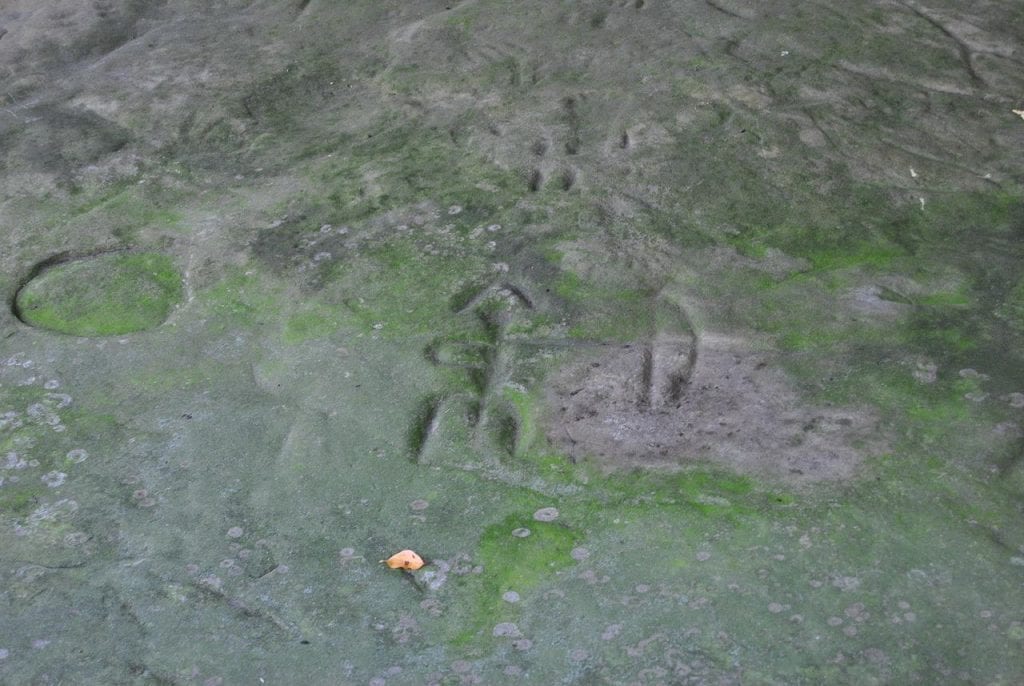In 2007, Mark Holley, a professor of underwater archaeology at Northwestern Michigan College in Traverse City, discovered a series of stones. Some of them arranged in a circle, one of which seemed to show an outlined carving of a mastodon. Mastodons died out almost 10,000 years ago. This ancient formation is located in an undisclosed location 40-feet beneath the surface waters of Lake Michigan.
Michigan’s Prehistoric Past
If verified, the carvings could be as much as 10,000 years old – coincident with the post-Ice Age presence of both humans and mastodons in the upper Midwest.

In a report by Holley and Brian Abbott to document the expedition, we learn that the archaeologists had been hired to survey a series of shipwrecks using sector scan sonar. The pair was trying to look for lost shipwrecks. What they encountered has been viewed as one of the most incredible archaeological discoveries in decades.
One boulder in the formation is of particular interest. Etched with the markings is 3.5 to 4 feet high and about 5 feet long. Photos show a surface with numerous fissures. Holley said some might be natural while others appear of human origin, but those forming what could be the petroglyph stood out.
Skeptics of Lake Michigan Stonehenge Stone Circles

Viewed together, they suggest the outlines of a mastodon-like back, hump, head, trunk, tusk, triangular-shaped ear, and parts of legs, he said.
There is obviously some doubt about whether or not that really is a mastodon carved on a rock. Furthermore, it’s equally uncertain if it really was the human activity that arranged some of the rocks. An article in Discover Magazine noted, “The stones are small and arranged in a V-shape instead of a circle. Plus, the supposed mastodon image hasn’t been analyzed to prove whether it’s a carving or a natural feature of the rock.”
Michigan’s Other Ancient Rock Structures
It’s worth pointing out that Michigan has several petroglyphs, stone circles, and unusual standing stones. For example, on nearby Beaver Island in Lake Michigan, there are groups of stone circles with carvings and etchings. Some of the rocks had holes, scribed lines, including the image of sheaves of feathers.
Just off the coast of Alpena in Lake Huron, a hunting ambush site was located in 120 feet of water. These stone circles have been deemed hunting blinds on an ancient land bridge called the Alpena-Amberley Ridge. This site is almost in pristine condition due to its depth in cold freshwater. Similar structures have been found in the Arctic.
In Bad Axe, Michigan, in Huron County, there was documented evidence of earthworks. The Bad Axe post office sits on the site of a circular mound or earthwork in a swamp, “a spot of dry land twenty or thirty feet above the level of the swamp, with a wall of the earth extending around it.” One theory is that it was a Native American garden spot in an Oak clearing. Needless to say, the earthwork was destroyed in the 1800s.
Great Michigan Fires in the Thumb Reveal First Nation Artwork

The Sanilac Petroglyphs Historic State Park contains Michigan’s only known rock carvings attributable to Native American Indians in our own backyard. The park consists of 240 acres in Greenleaf Township, Sanilac County, in Michigan’s Lower Peninsula.
The carvings, known as petroglyphs, were discovered by residents after a fire swept through the Upper Thumb of Michigan area in 1881. It revealed rocks bearing the designs. Geologists have determined that the carvings were made 300 to 1,000 years ago because they are made in relatively friable sandstone. This dates to the Late Woodland Period. Not as old as the Great Lakes Stonehenge.
The Great Lakes Stonehenge requires a boat and diving gear to see. In contrast, our own petroglyphs can be seen anytime with a short walk from the parking at the Sanilac State Park.




